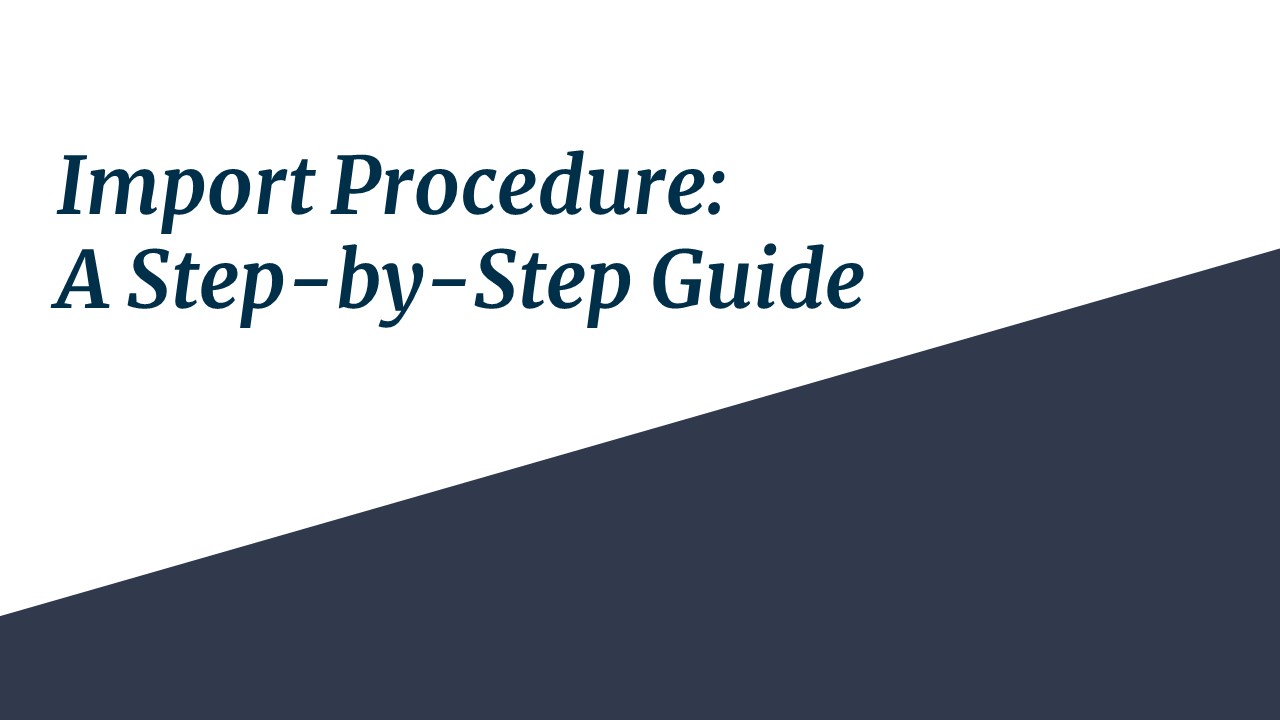Import Procedure: A Step-by-Step Guide - PowerPoint PPT Presentation
Title:
Import Procedure: A Step-by-Step Guide
Description:
For businesses in international trade, a well-executed import procedure is essential for a smooth supply chain, cost management, and regulatory compliance. Key steps include choosing suppliers, managing documentation, navigating customs clearance, and arranging transportation. Each stage impacts the efficiency of your import operations. Understanding these steps and applying best practices will optimize your process and give you a competitive edge. Master the essentials of successful importing—dive in now! – PowerPoint PPT presentation
Number of Views:4
Title: Import Procedure: A Step-by-Step Guide
1
Import Procedure
A Step-by-Step Guide
2
Introduction
- Importing products is a vital part of any
business looking to grow and stay competitive in
today's global market. - However, the import process can be complex,
involving regulatory compliance, documentation
management, and logistics coordination. - By mastering an effective import procedure,
businesses can streamline their operations,
control costs, and maintain a steady supply
chain. - Lets get started!
3
Understanding Import Procedure
- Every country and business imports goods to meet
local demand or access products that are not
available locally. - The import process involves steps like finding an
overseas supplier, negotiating deals, obtaining
permits, and clearing customs to bring goods into
the country. - Key stages in the import procedure include
planning, handling documentation, customs
clearance, arranging shipments, and receiving
goods. - Each stage is essential for ensuring a smooth and
efficient import process, which will be discussed
in detail in the next section.
4
Step 1. Planning and Preparation
- Conduct Market Research Analyze the demand for
products in your target market, the level of
competition, be updated on current market
trends to determine the viability of importing
specific goods. - Identify Reliable Suppliers Based on your
research, create a list of potential products to
import. Look for suppliers with a proven track
record of quality and timely delivery. Check
reviews and references to ensure reliability. - Understand Regulations and Restrictions Perform
thorough research to understand the regulatory
landscape, including safety standards, necessary
import permits, any industry-specific rules
that apply to the products you plan to import. - By carefully planning and preparing, you can
minimize risks and ensure a smooth import process.
5
Step 2. Obtaining Necessary Documentation
- Purchase Order (PO) This document outlines the
buyer's request for goods and specifies the terms
of purchase. - Commercial Invoice Provides transaction details,
including product description, quantity, price,
and payment terms. - Certificate of Origin Confirms the country where
the products were produced, essential for customs
and trade regulations. - Bill of Lading Issued by the carrier, this
transport document details the shipment and terms
of transport. - Preparing and Verifying Documentation Ensure all
documents are accurate and complete. Double-check
details to prevent errors, and consider
consulting a customs broker or trade advisor to
verify your paperwork.
6
Step 3. Customs Clearance
- Submit Import Documents Provide all required
documents to custom authorities to start the
clearance process. Customs will review these
documents to ensure compliance with import
regulations. - Pay Tariffs, Taxes, and Duties Based on product
classification, pay any applicable tariffs,
taxes, and duties. - Understand Tariffs Tariffs are taxes on imported
goods, calculated based on product valuation and
classification. Understanding these tariffs is
crucial for calculating the total cost of
importing and setting appropriate product prices. - Manage Tariffs Effectively Stay updated on
changes in tariff rates and trade policies. Work
with a customs broker to minimize tariff impacts,
navigate tariff schedules, and optimize your
import strategy.
7
Step 4. Arranging Transportation and Delivery
- Select Shipping Method Choose the appropriate
shipment mode based on the nature of your goods - Air Freight Ideal for high-value or
time-sensitive items, offering fast delivery. - Sea Freight Cost-effective for large quantities
of bulk goods, though less urgent. - Land Freight Suitable for importing goods from
neighboring countries. - Track Shipments Use carrier tracking systems to
monitor the status and location of your goods
throughout the journey. Regularly check updates
and address any potential delays or issues to
maintain a smooth supply chain.
8
Step 5. Receiving and Inspecting Goods
- Inspect Upon Arrival Conduct a thorough
examination of the shipment for any visible
damage. Verify that the quantity and quality of
the goods match the purchase order. - Handle Issues
- Document Problems Take detailed photographs and
descriptions of any damage or discrepancies. - Contact Supplier Reach out to the supplier to
resolve issues, which may involve a replacement
or refund. - File an Insurance Claim If applicable, file a
claim to recover costs associated with damaged or
incorrect goods.
9
Conclusion
- Mastering the import procedure is crucial for any
business aiming to thrive in the global market.
You have understand the import process and how to
effectively manage each stage from planning and
documentation to customs clearance and
transportation to streamline your operations,
control costs, and ensure a reliable supply
chain. - However, navigating the complexities of importing
isn't without its challenges. Get yourself fully
equip with strategies to overcome these hurdles
and discover best practices for successful
importing . - Explore expert strategies, tackle import
challenges, and learn best practices to elevate
your importing process and stay ahead in the
competitive market! - Dive deeper!































